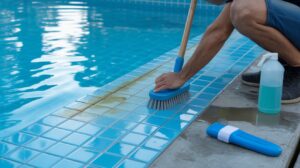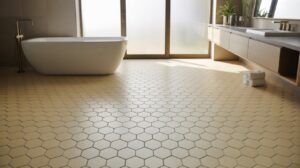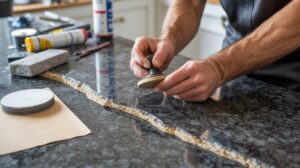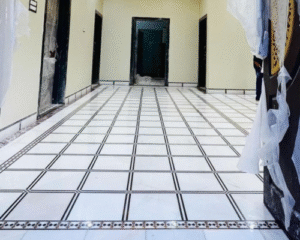Mastering the Art of Applying Non Slip Travertine Sealers
When it comes to safeguarding the elegance of your travertine surfaces, look no further than SF Marble And Granite Inc’s premium non slip travertine sealer. Our products are specially crafted to ensure your travertine not only retains its natural allure but also stays safe from potential slips and stains. Elevate your stone surfaces with the trusted protection of SF Marble And Granite Inc.
When it comes to preserving the beauty and longevity of your natural stone surfaces, such as travertine, finding the right sealer is paramount. In this comprehensive guide, brought to you by SF Marble And Granite Inc, we will delve into the world of non slip travertine sealers. From choosing the perfect sealer to application techniques and maintenance, we’ve got you covered.
Table of Contents
Toggle
Understanding the Importance of Non Slip Travertine Sealer
Travertine is a type of natural stone known for its unique patterns and warm colors. While it’s undeniably beautiful, it can also be quite porous. This means it’s vulnerable to staining and damage from everyday wear and tear. This is where non slip travertine sealer becomes crucial.
A non slip travertine sealer is a specialized product designed to enhance the safety and longevity of travertine surfaces. It offers several key benefits:
- Protection Against Stains: Travertine is susceptible to stains from spills and liquids. A sealer acts as a barrier, preventing these substances from penetrating the stone.
- Enhanced Durability: By sealing your travertine surfaces, you’ll significantly increase their lifespan. The sealer adds a protective layer that shields the stone from scratches and abrasions.
- Safety: The non-slip properties of these sealers make travertine surfaces safer, especially in areas prone to moisture, like bathrooms or kitchens.
- Preservation of Aesthetic: Sealing your travertine won’t alter its appearance; instead, it enhances the natural beauty of the stone, giving it a subtle sheen.
Choosing the Right Non Slip Travertine Sealer
When it comes to selecting the appropriate non slip travertine sealer for your surfaces, there are several factors to consider.
Factors to Consider:
- Travertine Type: The type and quality of your travertine can influence your choice of sealer. Some sealers are better suited for specific types of travertine, so it’s essential to match the product with your stone.
- Indoor or Outdoor Use: Consider where you intend to use the sealer. Indoor and outdoor environments have different requirements, and the sealer you choose should be suitable for your application.
- Desired Finish: Think about the finish you want to achieve. Some sealers provide a glossy finish, while others offer a more natural look. Your choice should align with your aesthetic preferences.
- Longevity: Assess the longevity of the sealer. Some sealers require more frequent reapplication than others, so consider your maintenance preferences and schedule.
- Ease of Application: If you plan to apply the sealer yourself, choose a product that matches your DIY skill level. Some sealers are more user-friendly than others.
- Compatibility: Ensure that the sealer you select is compatible with non-slip additives if you require enhanced slip resistance.
Why SF Marble And Granite Inc is Your Trusted Choice
SF Marble And Granite Inc stands out as a trusted choice for non slip travertine sealers for several reasons:
- Experience: With years of experience in the industry, SF Marble And Granite Inc has a deep understanding of travertine and sealing solutions. This expertise ensures that you receive the right product for your specific needs.
- Commitment to Quality: SF Marble And Granite Inc is committed to providing high-quality sealers that deliver on their promises. Our products undergo rigorous testing to ensure their effectiveness and longevity.
- Variety: We offer a diverse range of non-slip travertine sealers, catering to various travertine types, finishes, and applications. This variety allows you to find the perfect sealer for your project.
- Customer Satisfaction: SF Marble And Granite Inc values customer satisfaction above all else. Our sealers are designed not only to protect your surfaces but also to enhance your overall experience with your travertine.
- Expert Advice: Our team of experts is always ready to provide guidance and recommendations based on your specific requirements. We are here to ensure that you make an informed choice.
Preparation for Sealing
Before you begin the process of sealing your travertine surfaces, proper preparation is essential. This step ensures that the sealer adheres effectively and provides the desired protection. Here are two critical aspects of the preparation process:
Cleaning Your Travertine Surface:
- Gather Your Supplies: To clean your travertine, you’ll need a few basic supplies, including a pH-neutral stone cleaner, warm water, a soft mop or cloth, and a bucket.
- Sweep or Dust: Start by removing loose dirt and debris from the surface. You can use a broom or a dry, soft cloth to gently sweep or dust off any particles.
- Prepare a Cleaning Solution: In your bucket, mix warm water with a pH-neutral stone cleaner according to the manufacturer’s instructions. Avoid using acidic or abrasive cleaners as they can damage the stone.
- Clean the Surface: Dip your mop or cloth into the cleaning solution and wring it out well to avoid excessive moisture. Gently mop or wipe down the travertine surface, ensuring even coverage. Pay extra attention to any stained or soiled areas.
- Rinse Thoroughly: Once you’ve cleaned the surface, rinse your mop or cloth thoroughly and wipe down the travertine with clean, warm water to remove any residual cleaner.
- Dry Completely: Allow the travertine to air dry completely before proceeding with the sealing process. This ensures that no moisture is trapped beneath the sealer, which could affect its effectiveness.
Surface Inspection:
After cleaning your travertine, it’s essential to conduct a thorough surface inspection. This inspection helps you identify any existing issues that may need addressing before applying the sealer:
- Examine the Surface: Carefully inspect the entire travertine surface. Look for any cracks, chips, or areas of damage. Note their location and extent.
- Stains and Discoloration: Check for any stubborn stains or discoloration on the stone. Make a mental or written note of where these stains are located.
- Grout Lines: Inspect the grout lines if applicable. Ensure that they are in good condition and not cracked or deteriorating.
- Existing Sealant: If you have previously sealed your travertine, check for any signs of wear or deterioration of the existing sealer. This may include areas where the sealer has worn away, leaving the stone vulnerable.
Application Techniques
Applying non slip travertine sealer is a crucial step in protecting and enhancing your travertine surfaces. The right technique ensures that the sealer is evenly distributed, providing consistent coverage and long-lasting results.
Step-by-Step Guide:
Follow these steps for a successful application of non slip travertine sealer:
- Prepare the Surface: Ensure your travertine surface is clean, dry, and free from any dust, debris, or stains. Refer to the cleaning and preparation steps mentioned earlier.
- Ventilation: Make sure the area you’re working in is well-ventilated. Proper ventilation helps with the drying process and minimizes exposure to fumes.
- Choose the Right Sealer: Select the appropriate non-slip travertine sealer that matches your specific stone type, finish, and application requirements. Read the manufacturer’s instructions carefully.
- Protect Surrounding Areas: Use painter’s tape or plastic sheeting to cover and protect any adjacent surfaces or areas that should not come into contact with the sealer.
- Apply the Sealer: Depending on the sealer type, you can use a brush, roller, or spray applicator. Start in a small, inconspicuous area to ensure you are comfortable with the application technique and that it produces the desired finish.
- Even Application: Begin applying the sealer to the travertine surface in even strokes or sprays. Work methodically, ensuring that no area is missed. Pay extra attention to grout lines if applicable.
- Follow Manufacturer’s Instructions: Be sure to follow the manufacturer’s recommended drying times between coats if multiple coats are required. This information should be included in the product instructions.
- Apply Multiple Coats if Necessary: Depending on the sealer and the level of protection desired, you may need to apply multiple coats. Allow each coat to dry thoroughly before applying the next.
- Buff or Wipe Excess: After applying the final coat, carefully inspect the surface for any excess sealer. Use a clean, dry cloth to buff or wipe away any residue to achieve a uniform finish.
- Allow Proper Drying Time: Let the sealer dry completely. This may take several hours or even a day, depending on the product and environmental conditions.
- Inspect for Uniformity: Once the surface is dry, inspect it for uniformity. The sealed area should have a consistent appearance without streaks or blotches.
Common Mistakes to Avoid:
To ensure a successful sealing process, avoid these common mistakes:
- Overapplication: Applying too much sealer can lead to an uneven finish and a sticky residue. Follow the manufacturer’s guidelines for the correct amount.
- Skipping Surface Preparation: Failing to clean and prepare the surface properly can result in poor adhesion and ineffective sealing.
- Neglecting Ventilation: Insufficient ventilation can prolong drying times and expose you to potentially harmful fumes.
- Using the Wrong Sealer: Using an incompatible or incorrect sealer for your travertine type and finish can lead to unsatisfactory results.
- Not Following Instructions: Always read and follow the manufacturer’s instructions for the sealer you’re using, including drying times and reapplication recommendations.

Drying and Curing Process
After you’ve successfully applied the non slip travertine sealer to your surfaces, it’s crucial to allow for proper drying and curing. This phase ensures that the sealer bonds effectively with the travertine, providing long-lasting protection.
Drying Phase:
- Initial Drying: The initial drying phase begins immediately after you’ve applied the sealer. During this time, the sealer starts to evaporate, leaving behind a protective film on the surface of the travertine.
- Ventilation: Proper ventilation is essential during the drying phase. Open windows and doors, or use fans to circulate air. Adequate ventilation helps speed up the drying process and reduces the concentration of any fumes emitted by the sealer.
- Drying Time: The specific drying time can vary depending on factors such as the type of sealer, humidity levels, and temperature. Typically, the initial drying phase may take a few hours, but it’s advisable to follow the manufacturer’s recommendations for the sealer you’ve chosen.
Curing Phase:
The curing phase follows the initial drying and is equally important in achieving optimal protection:
- Complete Curing: While the initial drying phase makes the surface touch-dry, complete curing takes longer. Curing refers to the sealer’s chemical bonding with the travertine. This phase strengthens the protective barrier.
- Patience is Key: Allow ample time for the sealer to cure thoroughly. This may take up to 24 hours or more, depending on the sealer type and environmental conditions. Avoid any foot traffic or contact with liquids during this period.
- Do Not Rush: Resist the temptation to expedite the curing process. Premature use or exposure to moisture can compromise the effectiveness of the sealer.
- Regular Inspection: While the sealer is curing, periodically inspect the surface for uniformity and any signs of unevenness. If you notice any issues, consult the manufacturer’s guidelines for corrective measures.
Maintaining the Sealed Surface
Once the drying and curing process is complete, your travertine surface should be well-protected. To maintain its beauty and durability, follow these essential maintenance tips:
- Regularly clean the surface using a pH-neutral stone cleaner and avoid harsh chemicals that can damage the sealer.
- Be cautious with heavy furniture or sharp objects that could scratch the surface.
- Wipe up spills promptly to prevent staining.
- Reapply the sealer as recommended by the manufacturer or when water droplets no longer bead on the surface.
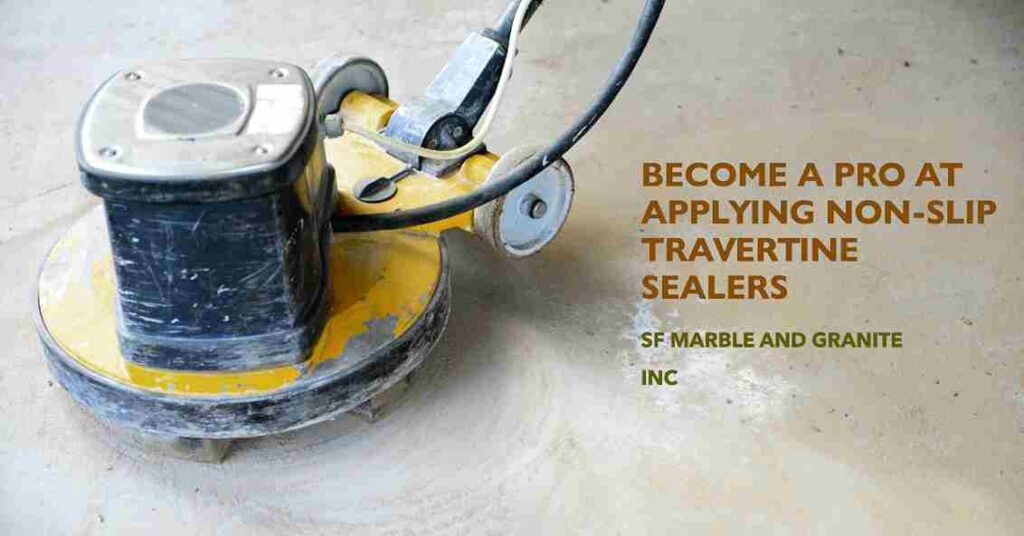
Call to Action: Enhance Your Surfaces with SF Marble And Granite Inc
Are you ready to transform your travertine surfaces into stunning, long-lasting masterpieces? Look no further than SF Marble And Granite Inc – your trusted partner for all your stone sealing needs.
Explore SF Marble And Granite Inc’s wide range of services, including granite fabrication and stunning swimming pool tile installations. Discover how we can transform your spaces with the timeless beauty of stone. For inquiries and expert guidance, don’t hesitate to contact us today. Your dream project is just a click away.
Why choose us?
- Experience: Our extensive experience in the industry means we understand the unique characteristics of travertine and can recommend the perfect sealer for your specific needs.
- Quality Assurance: SF Marble And Granite Inc is synonymous with quality. Our sealers undergo rigorous testing to ensure they deliver the promised protection and longevity.
- Product Variety: We offer a diverse selection of non-slip travertine sealers to suit different types of travertine, finishes, and applications. You’re sure to find the ideal solution for your project.
- Customer Satisfaction: Your satisfaction is our top priority. We don’t just provide sealers; we provide solutions that enhance your overall experience with your travertine surfaces.
- Expert Guidance: Our team of experts is always here to offer guidance and recommendations tailored to your specific requirements. We want you to make an informed choice.
Don’t wait any longer to safeguard and elevate the beauty of your travertine surfaces. Contact SF Marble And Granite Inc today and embark on a journey to enjoy lasting protection, enhanced aesthetics, and peace of mind.
Conclusion
In the realm of preserving and enhancing the timeless beauty of travertine surfaces, the importance of non slip travertine sealer cannot be overstated. This comprehensive guide has taken you on a journey through the intricacies of selecting, preparing, applying, and maintaining these sealers, ensuring that your travertine surfaces remain both captivating and durable.
Travertine, with its unique patterns and warm hues, deserves nothing but the best protection, and non slip sealers are the key to achieving that. From safeguarding against stains and wear to providing enhanced slip resistance, these sealers are your travertine’s best friend.
FAQs
What is a non-slip travertine sealer?
A non-slip travertine sealer is a specialized sealant designed to enhance the safety and durability of travertine surfaces. It provides slip resistance, protects against stains, and preserves the natural beauty of the stone.
How often should I reapply the sealer?
The frequency of reapplication depends on factors like usage and environmental conditions. Typically, resealing is necessary every one to three years, but it’s advisable to follow the manufacturer’s recommendations.
Can I use non-slip sealer on other stone surfaces?
While non-slip sealers are designed for travertine, some may be suitable for other stone types. It’s essential to consult with the manufacturer or a professional for recommendations.
Is professional application necessary?
Professional application is recommended for the best results, but experienced DIYers can also undertake the process. Proper technique and adherence to manufacturer instructions are essential.
Can I DIY the sealing process?
Yes, you can. However, it’s crucial to follow the manufacturer’s instructions carefully and use the right tools and techniques for even application.
How do I remove stains from a sealed travertine surface?
Gentle cleaning with a pH-neutral stone cleaner is usually sufficient to remove stains from a sealed travertine surface. Avoid harsh chemicals that can damage the sealer.
Contact Us

